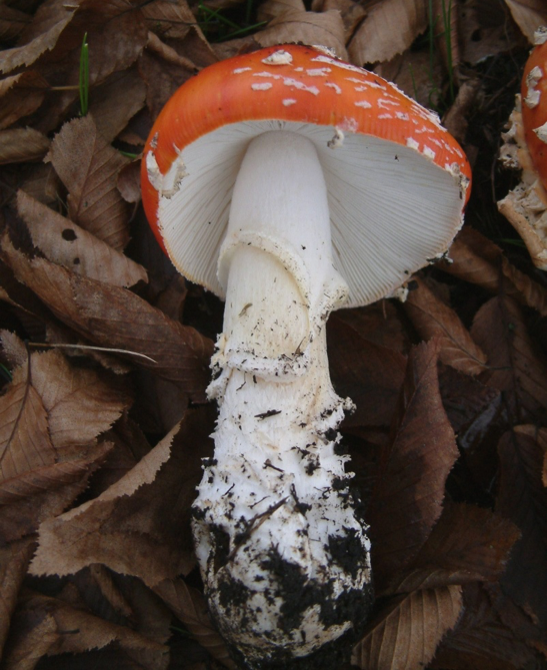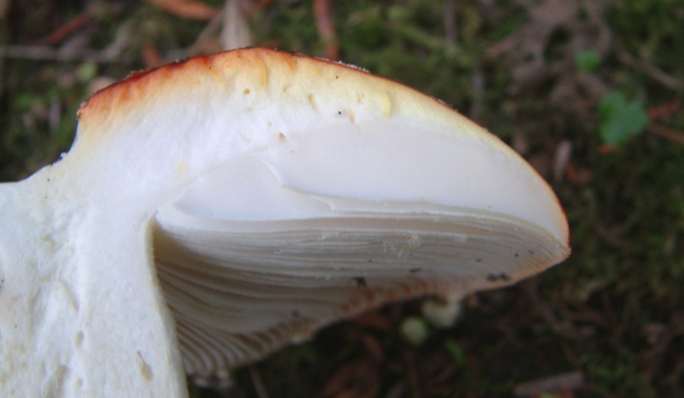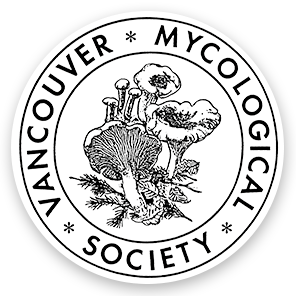
Amanita muscaria in Vancouver. Photo by Paul Kroeger
Poisonous, contains neurotoxins causing inebriation and delirium.
Toxins: Isoxazole compounds called Ibotenic acid, muscimol, and muscazone. Small amounts of muscarine may also be present.
Fly Agarics grow from the ground near both conifers and broadleaved trees and may be common and widespread in the late summer and autumn. These are rather large and stout Amanitas, the cap is often wider than the stem is long. They occur in a variety of colour forms with almost white through yellow to orange to very dark red or even brown caps. The variety described here is typical for the red capped material found most often in coastal BC. They make white spore prints.
Caps 5 to 20 (25) cm wide, beginning as a hemispheric bump on top of the large developing ‘button’ but soon expanding to globular in shape and expanding further to be domed or convex to flattened or uplifted in age, viscid when wet and young, a bright red, scarlet when young fading toward the margin to orange or yellowish especially when rain soaked or exposed to strong sun. Cap margin is striate when young becoming strongly so in maturity, these striations being grooves corresponding to the gills separated by a raised ridge often with fine bumps, called tuberculate striate. Cap has scattered to dense warts or scales of whitish, cream or slightly yellowish veil material often very pyramidal in shape or aptly described as looking like “cottage cheese”. These warts are often densely distributed over the centre and more scattered toward the cap edge, and may be wiped or washed away. The flesh of the cap immediately beneath the surface is red then orange to yellow lower, then white. Flesh does not stain when cut or bruised.

Section of A. muscaria showing pigmentation and gill attachment. Photo by Paul Kroeger
Gills are white and crowded and free from the stem. Partial gills are many and truncate. The edges of the gills often have a powdery or granular fringe.
Stems are 5 to 18 cm tall and 1 to 3 cm wide and are upward tapered, white, with an expanded or bulbous base. There is usually a large well-developed skirt-like hanging ring or annulus on the upper stem which is smooth on the upper side and often has a thick cream to yellowish edge. The volva is thick and leaves more or less diagonally arranged broken bands and ridges of loose cottony white to yellowish-cream material adhering to the lower stem.
Microscopic: Spores are 9.4-13.0 x 6.3-8.7 microns, broadly elliptic to elongate, smooth, thin-walled and hyaline, non-amyloid (not blue in Melzers iodine solution).
The Fly Agaric is one of the most conspicuous and showy mushrooms and is familiar to most people as the classic toadstool. It is rarely consumed accidentally. It is intentionally ingested by some people seeking the inebriating effects, but unlike ingestions of the Panther Mushroom, these people rarely come to medical attention. This is probably because Fly Agarics contain lower and more consistent quantities of the isoxazole neurotoxins resulting in milder and more predictable effects. It should be noted that while quite a few people have experimented with eating Fly Agarics and Panther Mushrooms, very few people choose to use them repeatedly.
There are several colour forms found in Amanita that were previously formally recognized as named varieties:
- Whitish caps with tan buff warts and white stem turning yellowish where handled characterized the variety alba, which is common in eastern North America but rare in the west.
- Yellow to yellowy orange caps with yellowish to pale yellow tan warts and white stem surface becoming yellowish where handled were considered as belonging to the variety formosa. These are common in the west especially under Poplar trees and in interior pine woods.
- Vivid red or orange-red caps with distinctly yellowish warts and yellowish volval remnants and white stem surface turning tannish where handled were referred to as variety flavivolvata.
- Brown caps indicate the rare form of Amanita muscaria called the variety regalis. Though this mushroom resembles the Panther Mushroom the volva at the basal bulb is a series of more or less diagonal loose cottony yellowish-white bands ascending some way up the stem, rather than an abrupt single white collar or rim (see Amanita pantherinoides).
Molecular data unfortunately does not support this neat classification by colour characteristics. There appear to be at least three different lineages or clades or genotypes within our western North American Fly Agarics according to molecular studies but these do not correlate to colour forms or the named varieties.
Bibliography
Ammirati, Joseph F. 1985. Poisonous Mushrooms of the Northern United States and Canada. University of Minnesota Press
Arora, David 1986 Mushrooms Demystified. Ten Speed Press. Berkeley CA
Arora, David 1991 All That The Rain Promises and More… Ten Speed Press. Berkeley CA
Benedict, Robert G. 1972 Mushroom Toxins Other than Amanita. Chapter 11 of Microbial toxins, edited by Kadis, SA, Ciegler, A and S Ajil, Vol. 8 (Fungal Toxins) Chapter 11, Acad. Press, New York.
Benjamin, Denis R. 1992 Mushroom Poisoning in Infants and Children: The Amanita pantherina/muscaria group. Clinical Toxicology 30(1):13-22.
Benjamin, Denis R. 1995. Mushrooms: Poisons and Panaceas. A Handbook for Naturalists, Mycologists and Physicians. W.H.Freeman and Company
Chilton, W.S. & Ott, J . 1976 Toxic metabolites of Amanita pantherina, A . cothurnata, A. muscaria and other Amanita species. Lloydia 39: 150 – 157
Davis, Betty L. 1981. Magic Mushrooms. Technical Report Series A-81-2 Province of British Columbia Ministry of Health Alcohol and Drug Programs, Victoria BC
Faulstich, H., B. Kommerell and Th. Wieland editors 1980 Amanita toxins and Poisoning. Verlag Gerhard Wilzstrock Baden-Baden Köln New York
Haard, Richard and Karen Haard 1980 Poisonous and Hallucinogenic Mushrooms. Homestead Book Co. Seattle
Jenkins, David T. 1977 A Taxonomic and Nomenclatural Study of the Genus Amanita Section Amanita for North America. Biblio. Mycol. 57: 1-126
Jenkins, David T. 1986 Amanita of North America. Mad River Press Eureka CA
Kent, Debra R. and Gillian Willis eds. 1997 Poison Management Manual. The BC Drug and Poison Information Centre Vancouver
Kühner, Robert & Henri Romagnesi 1953 Flora Analytique des Champignons Supérieurs. Masson et Cie, Editeurs Paris
Lincoff, Gary and D.H.Mitchel 1977. Toxic and Hallucinogenic Mushroom Poisoning: A Handbook for Physicians and Mushroom Hunters. Van Nostrand Reinhold Co.
Moser, Meinhard 1983 Keys to Agarics and Boleti. Roger Phillips, London
Ott, Jonathan 1976. Psycho-mycological studies of Amanita – From ancient sacrament to modern phobia. Journal of Psychedelic Drugs 8 (1): 27-35
Sept, J. Duane 2006 Common Mushrooms of the Northwest. Calypso Press.
Siegel, Noah and Christian Schwarz 2016 Mushrooms of the Redwood Coast: A comprehensive guide to the fungi of Coastal Northern California. Ten Speed Press, New York
Smith, Alexander H. 1975 A Field Guide to Western Mushrooms. The University of Michigan Press, Ann Arbor
Trudell, S. and J. Ammirati 2009 Mushrooms of the Pacific Northwest. Timber Press.
Turner, Nancy J. and Patrick von Aderkas. 2009 The North American Guide to Common Poisonous Plants and Mushrooms. Timber Press
Waser, P.G. 1967 The pharmacology of Amanita muscaria. In D.H. Efron, B. Holmstedt and N.S. Kline, editors Ethnopharmacologic search for psychoactive drugs, U.S. Government Printing Office, Washington, D.C. pp. 419-439. Publ.1979.
